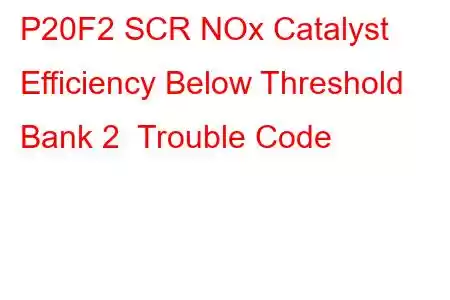P20F2 SCR NOx Catalyst Efficiency Below Threshold Bank 2
OBD-II Trouble Code Technical Description
SCR NOx Catalyst Efficiency Below Threshold Bank 2
What does that mean?
This is a generic diagnostic trouble code (DTC) and applies to many OBD-II vehicles (1996-newer). That may include but is not limited to vehicles from Audi, Buick, Chevrolet, Ford, GMC, Mercedes-Benz, Subaru, Toyota, Volkswagen etc. Although generic, the exact repair steps may vary depending on year, make, model and powertrain configuration.
When a P20F2 is stored in a diesel powered, OBD-II equipped vehicle, it means that the powertrain control module has detected that catalyst efficiency is below threshold for a certain engine bank. This particular code applies to the downstream catalytic converter (or NOx trap) for engine bank two. Bank two is the bank of the engine that contains the number two cylinder.
While modern, clean-burning diesel engines have many advantages over gasoline engines (especially in commercial truck applications), they also tend to produce more of certain harmful exhaust gases than other engines. The most notable of these offensive pollutants are ions of nitrogen oxide (NOx).
Exhaust gas recirculation (EGR) systems help to dramatically reduce NOx but many of today’s powerful diesel engines cannot meet strict federal (U.S.) emission standards using the EGR system alone. For this reason, SCR systems were developed.
SCR systems inject diesel exhaust fluid (DEF) into the exhaust in front of the catalytic converter or the NOx trap. The introduction of DEF raises exhaust gas temperature and allows the catalyst element to perform more efficiently. It makes the catalyst last longer and allows fewer NOx emissions to be released into the atmosphere.
Oxygen (O2) sensors, NOx sensors, and/or temperature sensors are placed before and after the catalyst to monitor its temperature and efficiency. The entire SCS system is controlled by either the PCM or a stand-alone controller which interacts with the PCM. Either way, the controller monitors the O2, NOx, and temperature sensors (as well as other inputs) to determine the appropriate time for DEF injection. Precise DEF injection is necessary to maintain exhaust temperature within acceptable parameters and promote optimum NOx filtration.
If the PCM detects a catalyst efficiency that is insufficient for minimum allowble parameters, a code P20F2 will be stored and a malfunction indicator lamp may be illuminated.
What is the severity of this DTC?
Any stored SCR related codes may initiate the SCR system being disabled. The stored code P20F2 should be considered severe and addressed as quickly as possible. Catalyst damage could result if the code is not rectified quickly.
What are some of the symptoms of the code?
Symptoms of a P20F2 trouble code may include:
Excessive black smoke from vehicle exhaust Diminished engine performance Reduction in fuel efficiency Other stored SCR and emission related codesWhat are some of the common causes of the code?
Causes for this code may include:
Defective O2, NOx, or temperature sensor Inoperative SCR system Faulty SCR injector Incorrect or insufficient DEF fluid Bad SCR controller or programming error Pre-catalyst exhaust leaks Installation of aftermarket or high-performance exhaust componentsWhat are some P20F2 troubleshooting steps?
If other SCR or exhaust emissions codes or exhaust temperature codes are stored, these should be addressed before attempting to diagnose the stored P20F2.
Any pre-catalyst exhaust leaks should be repaired before attempting a diagnosis for this type of code.
Access to a diagnostic scanner, a digital volt/ohmmeter (DVOM), an infrared thermometer with a laser pointer, and a source of vehicle specific SCR system diagnostic information will be required to d
Read: 22


